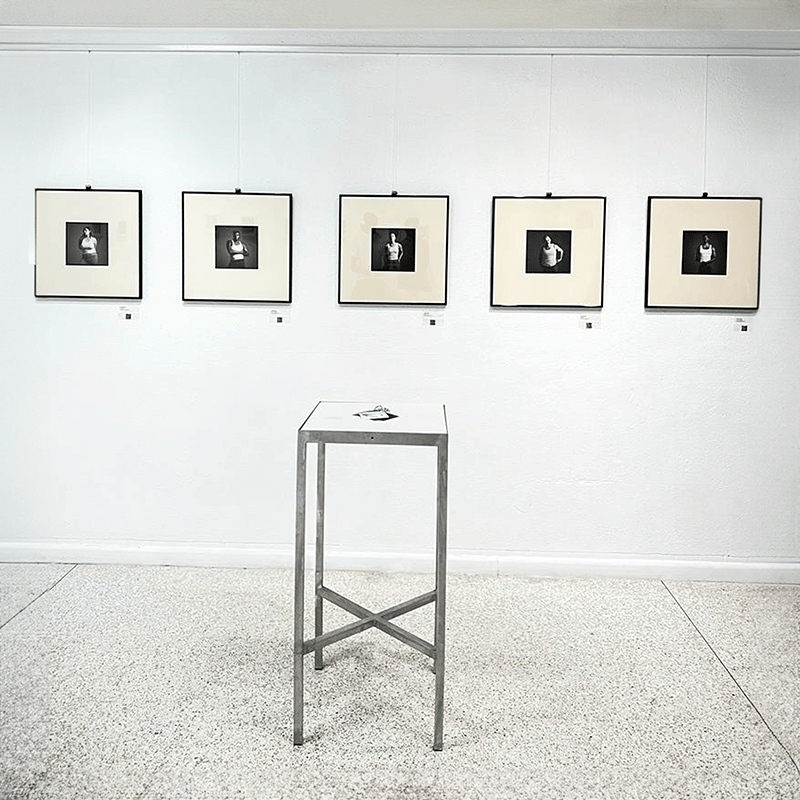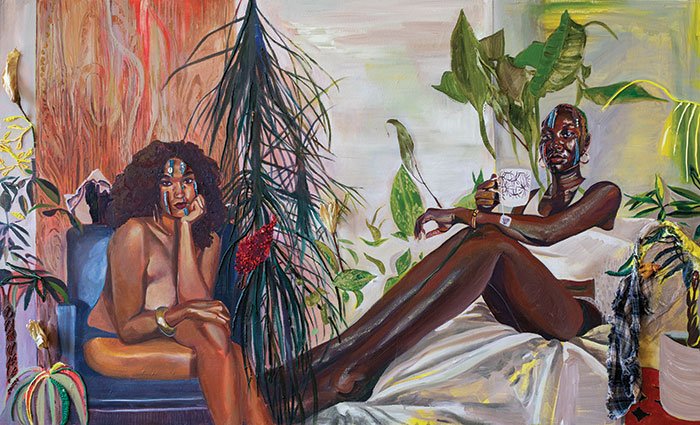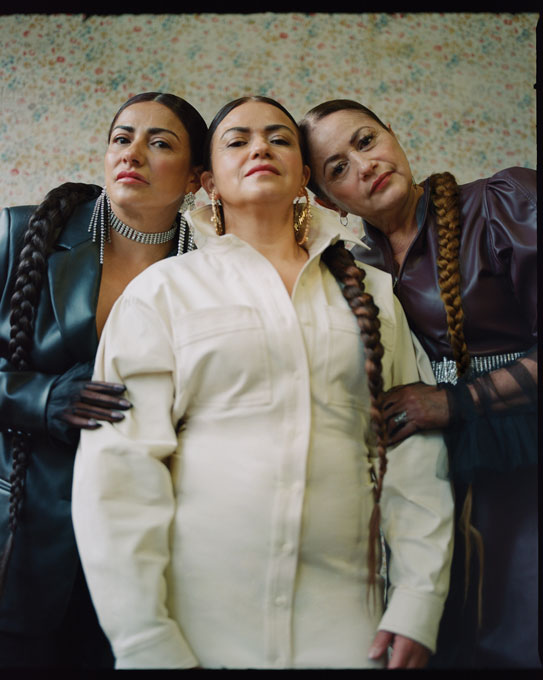ART
Suzanne Scott

Emerald
My suede boots are thoroughly soaked. It’s a cold, rainy, windy February day in New York City, and I’m frozen to the bone. I hop-skip across the street and splash through a puddle next to the gutter. Great.
I swipe through the raindrops on my phone to make sure I’ve got the right address, then make my way up to the fifth floor of an old red building just off Washington Square Park. I knock on the door and jump about five feet in the air when I’m greeted by barks from the other side.
Artist Suzanne Scott opens the door and ushers me in, while her very vocal furry friend, Lou Lou the coonhound, inspects me and my soaking boots. Scott’s apartment is a warm, cozy artist’s retreat in the middle of Manhattan, filled with twenty years of her memories and memorabilia. It’s one of those charming NYC hideaways that play with your perception of space, sneaking storage behind a wall of mirrors and a bed tucked away overhead in a loft. The walls are covered in art; paintings from friends as well as her own work. A large painting of Chuck Close, Scott’s mentor, hangs in the kitchen.
We make our way through to the living area, passing all types of gems and stones along the way. The living room is anchored by a massive library wall, with rows and rows of books leading all the way up to the 20-foot ceilings above. Moroccan rugs from past travels are layered in a patchwork across the floor. Fleetwood Mac’s “Rumours” album hums gently in the background, controlled by Alexa, who is asked to turn it down a notch.

You Should Never be a Redhead

It’s Called Limbo
Scott settles cross-legged into the plush leather of a nearby chair, a midcentury swiveler of Danish style. She is dressed in black from head to toe, with a plethora of metal jewelry wrapped all about her; neck, hands, wrists, and ears all glint in the warm afternoon light bouncing off the amber woods around us. She is charming, a warm calming energy like the amber blonde of her hair, piled into a messy bun atop her head. Several dark tattoos peek out from beneath the jewelry along her arms, mostly phrases and quotes that have impacted her life. One is a Bukowski quote that is marked on his grave: “Don’t try.” This was his approach to creativity – view it as a fly that comes in and smack it down; let it come to you, and then nail it.
The apartment is adorned with several of Scott’s signature pieces, the fingerprint portraits. “They all point to some specific time in my life, some phase that I’m experiencing,” she says. She painted her first print piece, a self-portrait, in 2000 after an especially nasty divorce. “I had to start over from scratch, and I had such amazing support from my friends. It was so unprovoked and beautiful; the outpouring was incredible. So, it was kind of a way to pay homage to humanity and just sort of pick out individuals and say thank you, and here you are and here’s how I feel about you and how grateful I am,” Scott says. We talk about the moods of the paintings; the rolling twirls and swirls of line and color, creating a living, breathing whirlpool across the canvas. “They’ve all got motion because it speaks to the evolution and the change and the human energy,” she says.

Purple Red Direction, Prism
When Scott decides she wants to paint a portrait, she pulls out her inks and takes down the subject’s fingerprints. This is the blueprint for the finished piece. From there, she sources colors that she feels represent the energy of the subject, shaded by her own personal experiences with them. Scott says the pieces take shape naturally, pulling and pushing in their own directions based on the movement suggested by their prints, as well as the sort of motion she associates with their personality.
Sometimes she holds onto prints for years before a painting ever comes about, like a set from her great-aunt that she obtained posthumously from a Coast Guard ID. “I can revisit a fingerprint that doesn’t change, and it can be a whole new portrait based on the same set of rules, but a completely different person given the circumstances,” she says. The fingerprint portraits are a synthesis of her background in realism and an abstract interpretation of the human spirit. “Realism is a nice exercise,” she says, “but for me, it is just following a set of rules and it isn’t as challenging. You have to make your own decisions in abstract.” The rocks and stones that surround us make their own appearances in Scott’s work. She has a set of paintings based on absorption spectrum photos of different gems and minerals, an idea sourced from her time studying to be a gemologist, someone who identifies and assesses stone. “It’s a fingerprint, but of a stone… a different way of identifying something in reality through abstract means,” she says.
The paintings are a series of bands, lines, and bars of color across a horizontal spectrum. They are taken directly from her textbooks, but show another view of a physical entity, as does a portrait. Scott’s paintings are rooted in science but grow into more esoteric, spiritual creations. One such painting is of Alexandrite, a dichroic stone that changes color depending on the type of light in its immediate environment: red in incandescent, green in UV. The story goes that Alexander the Great would use a ring made of Alexandrite to test the loyalty of his lovers, claiming that their hearts had turned when the colors did (in other words: a very easy way to get rid of those of whom he had grown tired). Scott believes there are energetic, less scientific sides to the gems as well. “I think about the amount of time that they’ve spent in the earth and that this can be created and untouched by man, just by virtue of the fact that it took all these hundreds of years to condense compressed energy. So in my mind, yes, there is energy vibrating out from those.”
Scott met Chuck Close in 2003 at a welcome party for Adam Weinberg, who had just been named the new director at the Whitney. They formed a quick friendship and have been collaborating artistically ever since. “I’ve learned so much about process from him, he’s so process-oriented. It’s about a set of rules and corrections,” says Scott. Close has been a strong supporter and constant enforcer of Scott’s in the years gone by. She credits him with teaching her about process, color theory, and relentless work ethic. As some may be unaware, Close, one of America’s most famous living artists, is a quadriplegic. Scott secured his fingerprints many years ago; “if you don’t use your hands, your fingerprints go away,” she says. “I printed him again three weeks ago, and they’ve changed. As he ages, there’s this sort of mosaic of cracks and fractures.” Even without the most integral part of Scott’s traditional blueprint, she has found a way to paint a portrait. So where does she go from here? Recently, Scott has focused on translating her fingerprints into new forms of media. She spent the summer of 2017 in the south of France working with lithography: “It was maddening”. She has thoughts of putting her prints into textile form, creating tapestries of her twisting lines. Scott finds the fingerprints, and people behind them, to be a source of endless inspiration.
Taking one last glance around the apartment, I bid her goodbye and return into the rain with visions of fingerprints swirling in my head, and one specific quote from her running through my mind: “It sounds really hokey, but it’s all just energy, it’s just vibe; there’s no visual reference, nothing based in reality that I translate. It’s all just a record of psychology and feeling and energy. Pour out their soul and slap it on the canvas.”
Words by Addison Anthony









